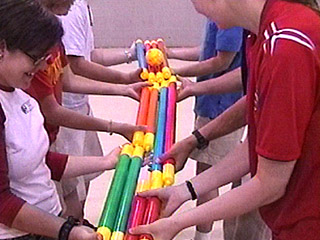Activity 5: Channels



Channels Activity
Activity Plan
Group Size: 5 - 10
Time: 20 - 40 minutes
Mental Intensity: 2
Physical Intensity: 2
Space: Lots
Objectives
- Brainstorm ways to create a channel to move the ball
- Communicate with team members to transport the ball into the bucket
- Work collaboratively to transport the ball
- Discuss their experience and feelings
Character Focus
Communication
Preparation
Time: 1 minute
Materials:
2 Toobeez tubes per person
1 Toobeez ball
1 bucket
1 envelope
chart paper (optional)
Setup:
- Place the Risk Taking Note into an envelope.
- Each person gets two tubes of equal length.
- Place a bucket a distance from where the group will set up.
The Challenge
The entire group must create a channel using the Toobeez to transport a ball into a bucket.
Safety Reminders!
Appropriate caution is important to conduct activities in a safe manner. Be sure to review these reminders prior to beginning the activity, and share reminders with the group if necessary.
- Follow general safety procedures
Helpful hints
- Encourage groups to start out moving slowly. The “leap frogging” requires timing, communication and focus
- Groups that rush can have an extremely difficult time with this activity
Activity Instructions
- Circle up the group. Distribute or display the appropriate “Risk Taking Note” for the activity. Have one participant read it aloud twice. Provide a few moments for the participants to think about the message:
“The distance is nothing; it is only the first step that is difficult.” - Madame du Deffand - Share the following storyline with group.
You are working together to create a new channel that will help people get fresh water! You must work together so that you can build this channel and get “water” into the bucket. You are doing great things! - Read aloud the following Activity Challenge Box to the group.
Challenge: The entire group must create a channel using the Toobeez to transport a ball into a bucket. Follow the guidelines below:- The ball may not touch anything other than the channels and the bucket
- The channels must remain in the air at all times
- When a ball is in your channel, your feet must remain still
- People may move when the ball is not in their channel
- The ball may not be touched once the activity has begun
- If any guidelines are broken, the group must begin again
- Before the participants attempt an activity challenge, have the group work through the following six steps:
- Circle up
- Know and understand the challenge and the guidelines
- Brainstorm
- Make a plan
- Do the plan
- Evaluate results and adjust as necessary
- The group will begin at an arbitrary starting point. Set a bucket approximately 30 feet from the group so the group must “leap frog” each other to successfully drop the ball in the bucket. The greater the distance, the harder the challenge.
- If participants get stuck, have the students circle up again. Here are some suggested questions to help guide the group back on track*:
- What is working?
- What ideas have you not tried yet that someone suggested?
- If your group is still struggling OR if you feel your group would benefit from an additional challenge, present a variation provided on the next page.
- After the activity, move to the debriefing questions for discussion.
Problem Solving Sequence:
Activity Variations
- Allow no participant contact.
Inform participants that they may not physically touch another person’s channel (but the channel tubes may touch one another). Also, the ball may only move in a forward direction; no backward rolling. - Add an obstacle.
Have the group transport the ball uphill (for example, up a staircase), under/over an obstacle such as a desk, tree, etc., or require the group to use NO verbal communication.
Debriefing the Activity
Use these debriefing questions as a guide for your discussion. Select the questions you feel will best benefit your group. It is not mandatory to cover every question. If possible, record the group’s responses on flip chart paper so all comments are displayed. Make sure to let everyone share their ideas, and remind participants that everyone’s opinions and feelings are important!
Base questions for debriefing:
- How did you feel when you first started building the channels?
- What was one of the challenges of doing this activity?
- If the ball represented the most important thing you have, describe how you took care of it.
- What were three different ways that you worked to pass the ball?
- What did the group have to do or believe to be successful?
- How can you apply what you just learned to other challenges you face?
If the group was unable to complete the task in the given time:
- What do you think you would have needed to do in order to succeed?
- Since you were not able to solve the problem, does it mean your group is a failure? (Push the group to respond with more than a “yes” or “no” and to instead point out and discuss what they learned.)
Additional questions: Choose which ones are the most appropriate:
- What was one positive thing that happened during the challenge?
- What did a fellow team member do that was really helpful?
- Did you try different ideas? If so, why did you change your approach?
Close on a Positive Note
Sum up the different ideas and feelings that you heard expressed, and restate ideas and learning moments the participants shared. Then, read the Risk Taking Note out loud again, and ask people to discuss what they think this note means. Discuss what they thought it meant at the beginning and what they think it means now.
* (ˆ) Do not provide the participants with answers. Allow them to work together.





